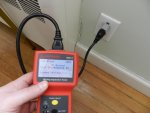Primitivelamps
Member
- Location
- Hampton, nh
Just purchased an AMPROBE INSP-3 wiring inspection tester. Does anyone have experience with this tester, good or bad? Concerned about accuracy. The first house I used it on was a 1947 cape. The up stairs outlets showed Voltage drops or 65.4% and 75.3% respectively (by the way the tenant mentioned that if they plug two or more things into the outlets they trip which would make sense to me with these numbers). Am I right the NEC recommends it be under 5%. The instructional manual that came with the unit list the following as possible problems creating excessive voltage drop:
Bad Splice
Loose screw Termination
Stripped thread on wire nuts or terminal screws
Faulty outlet
undersized wiring(too long of run for wire size)
loose connection at circuit breaker or fuse
corroded connections
overheating due to loose contacts
faulty or poor quality push in connections on receptacles
cold forming on aluminum wiring, causing loose connections
worn switch or circuit breaker contacts
I am a home inspector and would be recommending a licensed electrician to further investigate regardless because this house had other issues. But in the opinion of a licensed electrician(you guys) I guess I am wondering if this tool is accurate enough and what would be the most reasonable number to recommend follow up (anything over 5%?). Any advice is appreciated.
Thanks Terry
Bad Splice
Loose screw Termination
Stripped thread on wire nuts or terminal screws
Faulty outlet
undersized wiring(too long of run for wire size)
loose connection at circuit breaker or fuse
corroded connections
overheating due to loose contacts
faulty or poor quality push in connections on receptacles
cold forming on aluminum wiring, causing loose connections
worn switch or circuit breaker contacts
I am a home inspector and would be recommending a licensed electrician to further investigate regardless because this house had other issues. But in the opinion of a licensed electrician(you guys) I guess I am wondering if this tool is accurate enough and what would be the most reasonable number to recommend follow up (anything over 5%?). Any advice is appreciated.
Thanks Terry


